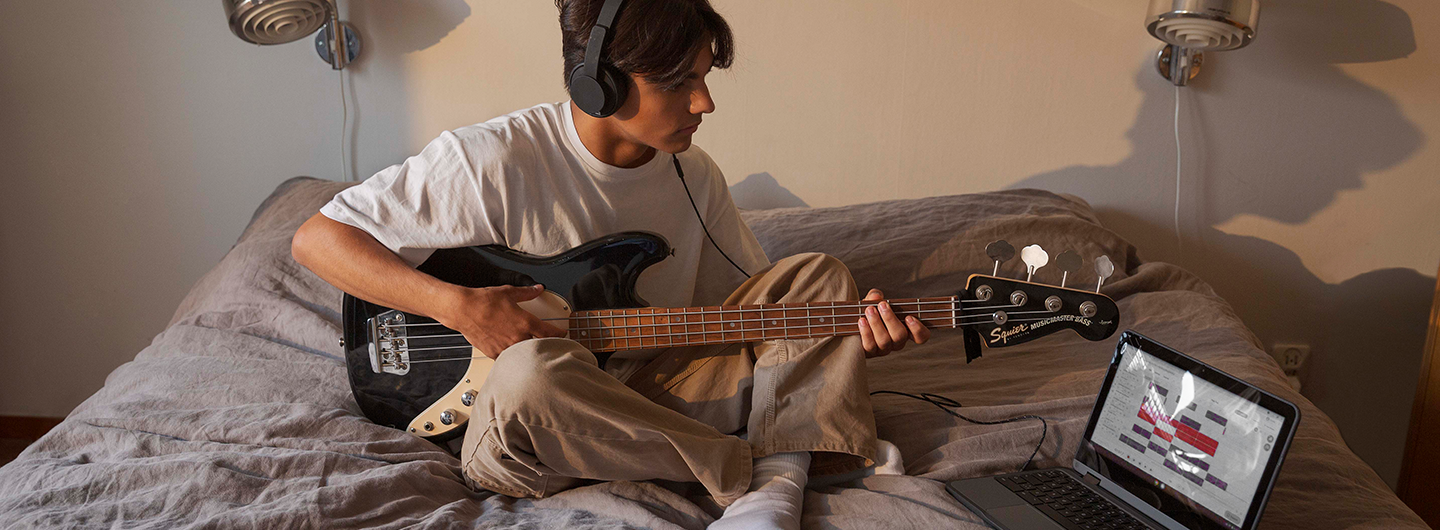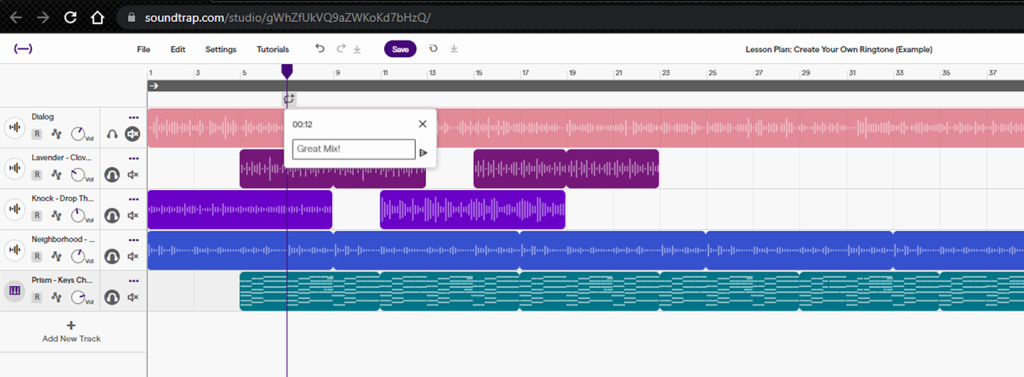
Teachers Make Collaboration Easy For Students with Soundtrap for Education
October 18, 2022Your students can spend the day scrolling through social media, listening to online lectures, and finishing their homework online, but can they successfully collaborate with their peers in an online-only environment? Through Soundtrap for Education, you can make collaboration easy.
In today’s technology-saturated world, students must know how to collaborate effectively in an online space. Although in-person communication is important, more organizations are looking to take a remote-first approach. Young people must understand how to communicate online to prepare for their future college classes and careers.
You might feel intimidated or hesitant to incorporate technology into your curriculum as an educator. Although justifiable with a complicated LMS, audio production can be much more straightforward. With the right digital tools, you can enrich your learning materials and boost student engagement while empowering your students to express themselves in their unique voices.
At Soundtrap for Education, we know that when the power of sound joins forces with seamless collaboration, students of all ages have the opportunity to transcend the limitations of traditional learning models and make magic. That’s why we’ve made collaborative learning even better with new features, unlike any audio production software you’ve seen.
What Is Soundtrap for Education?
Soundtrap for Education is a cloud-based audio recording studio where students and teachers can collaborate from any device, at any time, from any location within the safety of a digitally secure environment. Whether you’re teaching music, language arts, STEM, or even a business course, there is always an opportunity for you to facilitate effective collaboration with fun, engaging lesson plans.
Currently, Soundtrap for Education users can create unlimited projects while experimenting with thousands of loops, sound effects, instruments, and sounds. However, there are a few features users have been asking for, so we delivered. Throughout the end of 2022, we are releasing features to support you as you teach your students to collaborate. If you want to make successful collaboration a part of your teaching strategy, stay tuned!
The Benefits of Collaborative Learning Strategies
All this talk about collaboration may have you wondering why it’s so crucial in the modern classroom. The truth is today’s students are more isolated than ever. As online education and social media use continue to skyrocket, students are missing out on the ability to develop the critical teamwork skills that will carry them throughout their working lives. Traditional, in-person collaboration can undoubtedly be effective when students learn to work together as a team. However, in the digital era, students must master the art of online collaboration to connect within a more decentralized world.
Furthermore, working collaboratively is proven to have significant benefits regarding information retention and engagement. With the right digital tools, you and your students will reap the following benefits of collaborative learning strategies.
Improved Knowledge and Skill Acquisition
Studies show that collaborative learning is significantly more effective than traditional learning models at allowing students to understand complex concepts. Currently, most educational institutions follow a learning model in which educators share information with students via in-person or video lectures, and students are expected to retain the information.
Collaborative learning strategies revamp the student-teacher dynamic by encouraging students to process information through communication with one another. The Cognitive Load Theory, as described by Kirschner (2018), states that a person’s ability to process vast amounts of information is inherently limited and that it is easy for students to experience “information overload” when learning in solitude. However, collaborative learning exercises distribute this information to multiple people, improving the group’s collective working memory. In addition, cooperative learning reduces your cognitive load as an educator because you are not solely responsible for relaying information to the entire classroom.
Increased Student Engagement
When students are solely responsible for their coursework, they may let their minds wander or lack the self-motivation necessary to complete a project successfully. However, when several students work as a team to complete a project, they work more efficiently to help each other succeed. Collaborative learning is a prime example of the Social Interdependence Theory, which occurs when an individual is in a situation in which they cannot succeed unless the entire group does their part.
As an educator, you can harness the power of the Social Interdependence Theory by implementing lesson plans that allow students to follow their individualized learning styles and then collaborate with other students to ensure that they achieve the lesson plan’s ultimate goal. When you combine this learning model with cloud-based educational software, your tech-savvy students will have a much more fun, engaging experience by collaborating with the digital tools that come to them intuitively.
Encourage Collaboration and Creativity with Soundtrap for Education
Soundtrap for Education has transformed the educational sphere like no other audio production platform in just five years. In the Soundtrap Studio, educators can assign lesson plans, implement their teaching strategies, and motivate students to find their creative voices together. It wasn’t always this way. But now, students of all ages and abilities can let their voices be heard uniquely with cloud-based audio production software.
As the world’s first cloud-based audio and music recording studio, Soundtrap for Education is ever-evolving, just like your students. That’s why we’re rolling out a few new features that will take online student collaboration to the next level. These features allow you to easily guide your students as they connect, collaborate, and create. And the best part is you can incorporate Soundtrap for Education on any platform, regardless of the subject you teach. You’ll love sharing these new features with your students if you’re ready to facilitate collaboration in new, exciting ways.
Collaborate Seamlessly with “Comments”
We’ve just released our Comments feature, which allows every collaborator to provide input on any project. If you’re familiar with GoogleDocs, then you may already have a good idea of how this feature works. Students can communicate with one another independently about specific parts of a project without the hassle of moving to another messaging platform and fracturing a communication thread. In addition, collaborators can also add suggestions, notes, questions, and feedback.
Using the Comments features is just as easy and intuitive as you think. All you need to do is click the comment symbol in the timeline area. Once the comment dialog opens, you can add the comment anywhere you please, at any timestamp. You can also edit your comments or share existing comments simply by copying the link for seamless collaboration anytime, anywhere.

The “Comments” feature gives collaborators the ability to provide for each other feedback as the tracks are laid.
Use Live Collaboration to Create in Real Time
At Soundtrap, we know that collaboration is the driving force behind every groundbreaking creation, especially in making music. So, it only seems natural that we add features that facilitate collaboration in real time in the months ahead. With live collaboration and auto-save, users can view any changes without the need for a “sync” button. This way, your students have no interruptions when tapping into their creative flow.
Live collaboration will simplify teaching as well. If your students need a little guidance, you can jump into the project anytime and offer feedback without interrupting their creative genius. With autosave, your students won’t need to worry about losing their hard work. In addition, presence indicators allow you to see exactly who is working on a project, so it’s like everyone is working together in the classroom. Being creative is all about living in the moment, and live collaboration makes it easier than ever.
Recreate 808 Synth Sounds
Currently, students can work with over 2,000 beats and presets using many instruments, including synths, basslines, drum beats, and more. Students can also experiment with the Patterns Beatmaker to create extraordinary beats. However, Soundtrap for Education is releasing a new feature that will allow students to create on a whole new level. Soon, users will be able to recreate 808 synth sounds, enabling your students to express themselves authentically on any platform. By including the classic sounds of the 808 synths, students will be able to fully immerse themselves in the sounds that defined multiple generations of music makers.
Experience Limitless Collaboration with Soundtrap for Education
Authentic creation and effective collaboration can only be achieved in the right environment. With these new features, there are no limits on how, when, or where users collaborate with one another.
Soundtrap for Education is the ultimate audio production platform for students and teachers to create and edit audio recordings. Pupils and educators can easily tap into their artistic side with this intuitive audio platform. The platform facilitates a creative learning environment for every subject, regardless of the student’s age or experience level.
With Soundtrap for Education, students and teachers can collaborate with advanced cloud technology at any time or place. In addition, the platform is equipped with a robust resource portal. The robust portal comes equipped with tutorials, an external curriculum, and lesson plans to complete the educational experience. To ensure privacy, teachers can ensure that student collaboration is safe and secure with invite-only groups in Soundtrap’s versatile digital environment.
If you’re ready to enhance your educational experience with an intuitive cloud-based audio production platform, get started today with Soundtrap for Education! Share this article with other teachers in your network to help spread the joy of learning through sound.
 EDU Portal
EDU Portal


